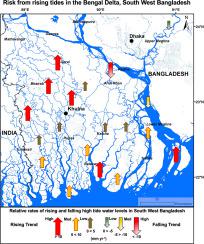Global and Planetary Change ( IF 3.9 ) Pub Date : 2021-09-09 , DOI: 10.1016/j.gloplacha.2021.103639 Sean E. Feist 1 , Mohammad A. Hoque 1 , Md. A. Islam 2 , Kazi M. Ahmed 3 , Mike Fowler 1

|
Accurately constraining local variation in tidal water levels is the vital first step in managing the risk of coastal hazards associated with sea level rise (SLR). Here we show sub-regional patterns in delta tidal dynamics and coastal SLR along the northern Bay of Bengal based on long-term (1990 to 2017) in-situ measurement data. Seasonal trend decomposition combined with robust linear modelling are applied to determine rates of water level change, with an average rise in coastal extreme sea levels of 6.9 ± 2.1 mm yr−1 translating to increases of 5.1 ± 4.2 mm yr−1 in tidal water levels within the delta. Mean increases of 18.3 ± 4.1 mm yr−1 and 18.2 ± 6.8 mm yr−1 at high and low-tide respectively in tidally dominated rivers of southwest Bangladesh contrast with the fluvially active central and eastern sections of the delta where falling trends of −6.5 ± 2.3 mm yr−1 (high-tide) and −10.2 ± 3.1 mm yr−1 (low-tide) are recorded. Rapid changes in river level at individual sites can occur over periods of ca. 3 to 10 years, most likely resulting from short-term hydro-morphological changes. An acceleration of change in high-tides is indicated by a rise from the long term (1950 to 2018) rate of 4.4 ± 1.5 mm yr−1 to 5.9 ± 3.2 mm yr−1 between 1990 and 2017, leading to increased risk for the local population. At local and regional scales, the inland impact of SLR within the delta is observed to be strongly modulated, necessitating more detailed analysis of driving mechanisms at the site specific level. Our results can be used to aid development of adaptation strategies in Bangladesh and as a call for increased monitoring of hydro-morphological parameters within the Bengal delta and other large deltas in Asia and worldwide.
中文翻译:

孟加拉国沿海内陆水位变化的最新趋势——低洼三角洲海平面上升的影响
准确限制潮汐水位的局部变化是管理与海平面上升 (SLR) 相关的沿海灾害风险的重要第一步。在这里,我们根据长期(1990 年至 2017 年)原位测量数据显示了孟加拉湾北部三角洲潮汐动力学和沿海 SLR 的次区域模式。季节性趋势分解结合稳健的线性模型用于确定水位变化率,沿海极端海平面平均上升 6.9 ± 2.1 mm yr -1相当于潮汐水位上升 5.1 ± 4.2 mm yr -1三角洲内。平均增加 18.3 ± 4.1 mm yr -1和 18.2 ± 6.8 mm yr -1孟加拉国西南部以潮汐为主的河流分别处于高潮和低潮,而三角洲中部和东部河流活跃,下降趋势为-6.5 ± 2.3 mm yr -1(高潮)和-10.2 ± 3.1 mm yr -1(低潮)被记录。个别地点河流水位的快速变化可能会在大约 10 年的时间内发生。3 到 10 年,最有可能是由短期水文形态变化造成的。高潮变化的加速表现为从长期(1950 年至 2018 年)速率从 4.4 ± 1.5 mm yr -1上升到 5.9 ± 3.2 mm yr -11990 年至 2017 年期间,导致当地人口的风险增加。在局部和区域尺度上,观察到三角洲内 SLR 的内陆影响受到强烈调节,需要对特定地点的驱动机制进行更详细的分析。我们的结果可用于帮助孟加拉国制定适应战略,并呼吁加强对孟加拉三角洲和亚洲和世界其他大型三角洲内的水文形态参数的监测。


























 京公网安备 11010802027423号
京公网安备 11010802027423号